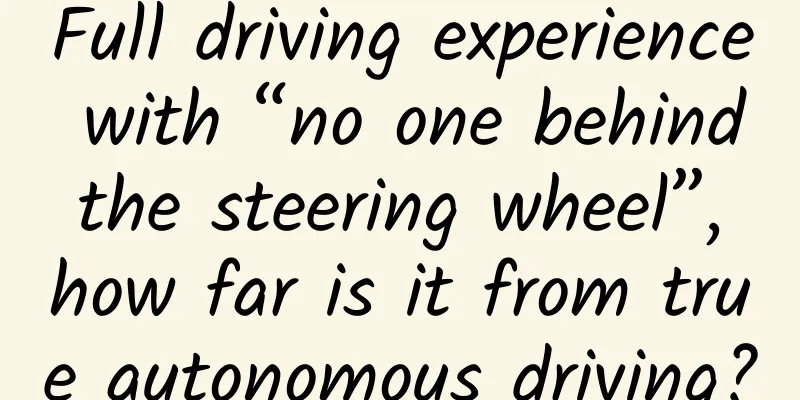Full driving experience with “no one behind the steering wheel”, how far is it from true autonomous driving?

|
Self-driving cars without drivers behind the steering wheel have quietly come to us and started to carry passengers. Does this mean that true self-driving is coming? The reporter conducted a field experience... Written by reporter Zhao Tianyu Edited by Ji Jingjing New Media Editor/Li Yunfeng Interview experts Gong Jianwei (Professor of School of Mechanical and Vehicle Engineering, Beijing Institute of Technology, Director of Intelligent Vehicle Research Institute) Cui Dongshu (Secretary-General of the National Passenger Vehicle Market Information Joint Conference) Zhang Ning (Vice President of Pony.ai and Head of Beijing R&D Center) ▲Reporters experience the unmanned driving car on the spot Starting, accelerating, changing lanes, turning, avoiding pedestrians and non-motor vehicles, driving on city roads... all these operations are actually completed by a car without a driver? Nowadays, such a sci-fi plot has appeared in our daily life. On April 28, Beijing issued a notice on unmanned manned demonstration applications, becoming the first city in China to launch a pilot program for unmanned passenger car operations. The first batch of 14 unmanned vehicles will be put into demonstration applications, and are allowed to provide the public with autonomous driving travel services with "no safety officer in the driver's seat and a safety officer in the passenger seat", which is what we see as "unmanned driving" today. This means that starting from May this year, within the 60 square kilometers of Beijing Economic and Technological Development Zone, citizens will not only be able to see vehicles with no one behind the steering wheel passing by, but will also have the opportunity to ride in such "autonomous driving vehicles" with no one behind the wheel to go to multiple subway stations, parks, sports centers, as well as key business districts and residential areas in Yizhuang. Beijing's opening of unmanned passenger vehicles is just one of the steps in the development of high-level autonomous driving: the future development will take time, technology improvement, and the improvement and perfection of laws. At present, people have high hopes for unmanned driving in terms of saving human capital, improving efficiency, and reducing traffic accidents. They also hope to leverage policies and technologies to take the commercialization of unmanned driving to a higher level. ▼ ▼ ▼ Driving without a driver: Experience a car without a driver In Beijing Yizhuang Development Zone outside the southeast fifth ring road, an SUV with an "unmanned driving" logo printed on it was waiting quietly at the traffic light. Later, the red light turns green, the car passes through the intersection and stops steadily on the roadside. This series of smooth operations is no different from ordinary cars, but when you look at the driver's seat of the car, you find that it is empty! There is no one in the driver's seat! ▲Unmanned test vehicle driving through the streets of Beijing Recently, the reporter experienced a "driverless driving" car. In addition to Baidu, Beijing Pony.ai Technology Co., Ltd. (hereinafter referred to as Pony.ai) is also one of the first companies in Beijing to be approved to conduct unmanned manned testing. Apart from the eye-catching laser radar on the roof, this self-driving car is not much different from an ordinary car. But in fact, this self-driving car modified from the Lexus RX series has made a lot of technological progress compared to its predecessors. It is equipped with the fifth-generation L4 autonomous driving software and hardware integration system developed by Pony.ai - PonyAlphaX; the whole vehicle is equipped with 4 laser radars for detecting objects around the vehicle and eliminating blind spots; it is also equipped with 7 cameras to more effectively deal with complex intersection scenes. There was no one in the main driving seat, the co-pilot was the safety officer, and the passengers were sitting in the back seat. After the safety officer shifted gears and clicked the button to confirm the trip, the main driving steering wheel began to "turn the wheel and change lanes" by itself, and the vehicle started! After starting to drive, the screen in front of the passenger will display road information including roadside environment, moving vehicles, pedestrians, etc., as well as the vehicle's driving status, route planning, etc. This is not much different from the first generation of self-driving cars with safety officers, but it can be clearly felt that the accuracy of identifying the surrounding environment is higher, and even green belts can be identified. ▲The unmanned autonomous driving car avoids pedestrians and turns around The test ride went around the southern part of the Economic Development Zone, across the two administrative districts of Tongzhou and Daxing, and covered a distance of more than 12 kilometers. Compared with the first generation of autonomous driving road test vehicles, the road conditions this time were more complicated, with multiple U-turns and turns, as well as the need to cross tram tracks and highway culverts, and more frequent mixing with private vehicles. However, the vehicles completed the manned mission smoothly and without any unexpected situations. In terms of driving logic, the vehicle drove smoothly when there were no U-turns, and it would actively accelerate on the main roads with light traffic. When pedestrians occasionally cross the road, vehicles on the adjacent lane cut in, or other vehicles make illegal turns at intersections, the unmanned vehicle will make timely plans and responses. For example, when pedestrians suddenly cross the road, the vehicle does not brake suddenly, but slows down and detours like an experienced driver. However, the reporter also found several shortcomings: First, although it has been mixed with other vehicles for a long time, it can only travel from station to station. During this process, the vehicle cannot stop unless the safety officer takes over or there is an emergency. Second, although the safety officer is no longer ready to take over the vehicle at any time, he still needs to manually shift the vehicle into the forward or parking gear when starting and stopping, otherwise the vehicle cannot be started or parked. When I asked the safety officer why, he explained that this was more due to the design and structure of the vehicle itself. Third, unmanned driving is highly dependent on network and system settings, and its performance in "intelligent planning" is not satisfactory: when the network conditions in the park are poor or the rules do not meet the requirements for unmanned operation, the automatic driving state cannot be activated. At this time, a safety officer is required to operate until the conditions are met. In general, this driverless test car is not much different from an ordinary car. At least on the road test section in the Economic and Technological Development Zone, it has reached the level of a human driver, performing more stably than a human beginner and more reassuring than a violent driver with road rage. When passing by oncoming vehicles, the empty driver's seat makes the human drivers of other vehicles look surprised - this may be the greatest pleasure of experiencing fully autonomous driving on public roads. ▼ ▼ ▼ Safety officers are "laid off", and autonomous driving is moving towards level 4 The operation of unmanned passenger vehicles in Beijing means that my country's autonomous driving has officially entered a new stage of commercial pilot exploration, and has also become the starting point for transforming China's future travel methods. Currently, the most widely used standard for autonomous driving is the American SAE standard, which is divided into 6 levels, of which levels 0-2 are driving assistance and levels 3-5 are autonomous driving. In layman's terms, drivers at the L1 and L2 levels can let go of their hands or feet as appropriate, but are required to monitor road conditions at all times; the L3 level means that the car can be driven automatically when conditions are met, and the driver is required to take over the vehicle if conditions are not met; the L4 level does not require the driver to monitor road conditions, and all road safety responsibilities for driving status are transferred to the car itself; the L5 level does not require a driver at all and is a true "driverless car." At present, L2 intelligent driving has been commercialized on a large scale in passenger cars. According to statistics, 22% of passenger cars in 2021 have been equipped with L2 and below autonomous driving systems. Technologies such as adaptive cruise control (ACC) and lane keeping control (LKS) have already entered the homes of ordinary people. However, due to the limitations of single-vehicle intelligence, domestic companies' attempts at L3 and higher-level intelligent driving are still focused on specific scenarios and limited scopes. In particular, from L3 to L4, the industry consensus is that a huge "chasm" needs to be crossed. The "chasm" here refers to the difference in driving subjects: When the vehicle needs to be taken over, the driver is still the driving subject at level L3, but at level L4 and above, fully autonomous driving can be achieved, and the autonomous driving system will fully control the vehicle to ensure safety. However, from the L3 to L4 stage, the driving is neither completely controlled by humans nor completely controlled by machines. Most of the fatal accidents that have occurred in the past few years are tragedies caused by humans trusting machines too much, while the technology is not yet sufficient to support machines to completely take over the vehicles. ▲In order to standardize the domestic autonomous driving standards, in August 2021, the GB/T40429-2021 "Automotive Driving Automation Classification" recommended national standard proposed by the Ministry of Industry and Information Technology and managed by the National Automobile Standardization Technical Committee was officially released and officially implemented on March 1 this year. This reminds people of the first generation of Robotaxi (driverless taxis/online ride-hailing vehicles) that went online in 2020 with a "safety officer as the main driver". Although it claimed to have reached the L4 level, because the safety officer was always "watching closely" and "taking over the vehicle at any time", people questioned whether its actual level was only L3 or L3.5. Does the self-driving car without the main driver fully meet the L4 standard? Zhang Ning, vice president of Pony.ai, one of the first companies to obtain the demonstration application license for unmanned vehicles, told reporters that when the (unmanned test) license was issued, it meant that the self-driving technology had matured to the point where a safety officer was not required in most scenarios. Although equipped with remote assistance, the remote assistance only provided decision-making assistance during the vehicle test. The self-driving vehicle still relied more on the vehicle itself to make planning and control to ensure safety. This is what we call Level 4 highly automated driving or L4 automated driving. Cui Dongshu, secretary-general of the National Passenger Car Market Information Joint Conference, also said that the routes of vehicles participating in unmanned testing are not set by the system or humans, but are calculated through algorithms and road tests, and can be adjusted according to the environment. The entire process is basically car-centered, with no driver involved, and can be considered to be at the L4 level. However, Gong Jianwei, professor of the School of Mechanical and Vehicle Engineering and director of the Intelligent Vehicle Research Institute of Beijing Institute of Technology, also reminded that the real L5 level "true autonomous driving" should be a vehicle that fully reaches the level of human drivers, does not need to be repeatedly tested on the road, and the driver does not need to set up steering wheel control buttons. The unmanned test vehicle has a technical breakthrough, but it is still more at the testing level. In the short term, L5 level true autonomous driving vehicles will not be able to be on the road. ▼ ▼ ▼ Targeting commercialization and seizing the new track of autonomous driving In addition to technological innovation, one of the ultimate goals of the "second half" competition in autonomous driving is also commercialization, and to seize many new tracks in the process. In 2020, the scale of China's LiDAR market increased by 82.61% from 2019 to US$420 million. According to research reports, by 2025, the scale of China's LiDAR market is expected to reach US$4.31 billion, among which autonomous driving and advanced driver assistance in the automotive field are the most important growth points. LiDAR is just one link in the autonomous driving industry chain. It is foreseeable that autonomous driving will bring more opportunities to supporting industries. Autonomous driving can also promote the development of new infrastructure, enhance vehicle-road coordination capabilities, improve transportation efficiency, and provide data and ideas for the rational scheduling of urban traffic. For the rapidly developing new energy vehicles and new car-making forces, higher levels of autonomous driving have become a very important selling point. ▲ Notice on unmanned demonstration application roads for passenger vehicles Source: Beijing Yizhuang WeChat Official Account Overall, as an intersection of the automotive industry and advanced manufacturing, autonomous driving can not only enhance the country's comprehensive scientific and technological competitiveness, but also extend the automotive industry chain, drive the growth of upstream and downstream companies, promote consumption, and become another powerful engine for economic development in the new era. On the other hand, the autonomous driving track is also facing global competition. American company Waymo is backed by the technology giant Google and has rapid technological iteration. After reaching cooperation with car companies such as Volvo, the product landing and commercialization process are also expected to achieve breakthroughs. It is a strong competitor to domestic companies. Compared with the small steps and quick progress in China, foreign autonomous driving policies are more daring: California in the United States allowed road testing of autonomous vehicles without steering wheels, pedals, and safety officers as early as 2018; in January 2021, the U.S. Department of Transportation allowed automakers to produce driverless vehicles without steering wheels and control pedals and put them into commercial use; starting in 2022, Germany allowed L4 driverless cars to drive in designated areas on public roads. Germany thus became the first country in the world to allow driverless vehicles to participate in daily traffic and be used nationwide. ▲In August 2021, Google's Waymo autonomous driving system was first tested in a large city with passengers The moderate advancement of laws and regulations ahead of industrial development will help boost industry confidence. 2022 is likely to be the year when human and vehicle responsibilities become differentiated, thereby accelerating the implementation of L4 autonomous driving. Therefore, Deng Zhidong, professor of computer science at Tsinghua University and expert in the autonomous driving industry, called for domestic policy planning and deployment to not only keep up with the rapid development of driverless cars in the United States and Europe, but also to be more conducive to the early realization of fully driverless cars on the road and the commercialization of the driverless industry, so as to achieve breakthroughs in policy support from point to surface, while making the corresponding safety risks controllable and predictable. "We must face up to the differences in unmanned driving technology and policies at home and abroad. Domestic unmanned driving is still in the testing stage, and large-scale commercialization will take some time." Cui Dongshu told reporters that conducting similar unmanned driving passenger trials in specific areas of the city, accumulating data and reducing safety risks are very important links in laying a solid foundation for commercialization. Gong Jianwei believes that the "gradual opening" that conforms to the current domestic situation has its value: "Policies affect the entire body. It is not only a technical issue, but also faces the pressure of legal ethics and social ethics. It should be gradually opened up in areas such as the Yizhuang high-level autonomous driving demonstration zone, and then consider the scope of the next step. At present, when the technical route is not yet mature, a large-scale opening is definitely unrealistic." Produced by: Science Central Kitchen Produced by: Beijing Science and Technology News | Beijing Science and Technology Media Welcome to share to your circle of friends Reproduction without authorization is prohibited |
<<: Don’t do these things within 30 minutes before doing nucleic acid testing!
>>: Have you discovered the secret to immortality? Longer telomeres = longer lifespan?
Recommend
APP operation and promotion tips: 37 free online promotion channels
The following is a complete guide that will intro...
Vanishing birdsong: How to track the impact of climate change on the region's soundscape?
The International Department of the China Biodive...
"People's hope" has not yet come true: Remdesivir still needs to be verified
The results of remdesivir in treating COVID-19 ar...
00Kb2's small plug-in can remove WeChat blocking!
[[351621]] Needless to say, everyone knows that t...
How to create a lucky draw app for WeChat official account? How much does it cost to create a WeChat lottery app?
Before we know it, another year has passed, and m...
How early was the earliest hot pot? Much earlier than Yao, Shun and Yu!
Frost has passed, is the beginning of winter far ...
After working on information flow for half a year, I found these 3 points to be super useful!
When it comes to information flow , I think most ...
How important is a perky butt to athletes? There are so many benefits to having a strong butt!
Ask a Question! What impressed you most about the...
Electric Technology Car News: Can the stylish exterior and exquisite interior of Jingyi X5 successfully break the existing SUV pattern?
On August 21, Dongfeng Fengxing's Jingyi X6 1...
"91 Ten Articles" - A daily must-read briefing for the new energy vehicle industry (210204)
1. BOSS Zhipin released the "Talent Attracti...
How to create short video marketing?
Nowadays, the times are developing faster and fas...
Yang Yuanqing: Motorola will return to the tablet market
Lenovo CEO Yang Yuanqing recently said that Lenov...
Flu ≠ cold! Don’t confuse them anymore! You must know these differences →
Although medicine has made great progress in the ...
Is growing taller painful? Uncovering the "little episodes" in the process of children growing taller →
Spring is the season of revival and the "gol...
Can refusing to follow the trend of IP help the rise of Chinese animation?
As intellectual property becomes more and more in...







![[Smart Farmers] Using "black technology" in the fields, unmanned agricultural machinery can farm the land on its own!](/upload/images/67f210467d14d.webp)

